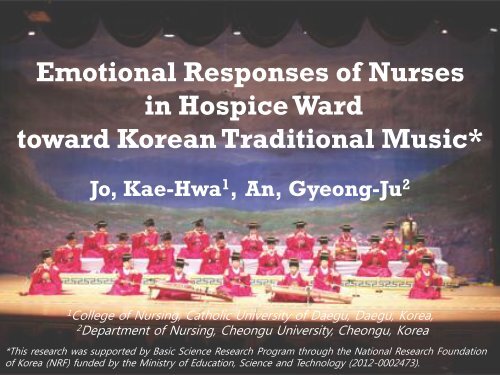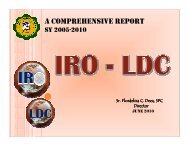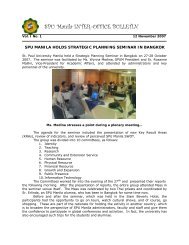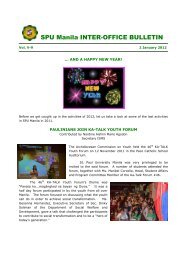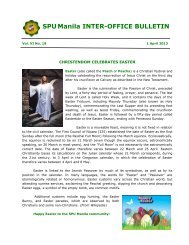Emotional Responses of Nurses in Hospice Ward toward Korean ...
Emotional Responses of Nurses in Hospice Ward toward Korean ...
Emotional Responses of Nurses in Hospice Ward toward Korean ...
You also want an ePaper? Increase the reach of your titles
YUMPU automatically turns print PDFs into web optimized ePapers that Google loves.
<strong>Emotional</strong> <strong>Responses</strong> <strong>of</strong> <strong>Nurses</strong><br />
<strong>in</strong> <strong>Hospice</strong> <strong>Ward</strong><br />
<strong>toward</strong> <strong>Korean</strong> Traditional Music*<br />
Jo, Kae-Hwa 1 , An, Gyeong-Ju 2<br />
1<br />
College <strong>of</strong> Nurs<strong>in</strong>g, Catholic University <strong>of</strong> Daegu, Daegu, Korea,<br />
2<br />
Department <strong>of</strong> Nurs<strong>in</strong>g, Cheongu University, Cheongu, Korea<br />
*This research was supported by Basic Science Research Program through the National Research Foundation<br />
<strong>of</strong> Korea (NRF) funded by the M<strong>in</strong>istry <strong>of</strong> Education, Science and Technology (2012-0002473).
Introduction<br />
1. Music help patients relax<br />
2. Slow-tempo music is more favorable<br />
3. <strong>Korean</strong> traditional music is based on Li-Yue thought <strong>of</strong><br />
Confucius<br />
4. <strong>Korean</strong> traditional music emphasizes sounds <strong>of</strong> the<br />
nature itself
Introduction<br />
5. Nurse <strong>in</strong> hospice ward treats the patients who suffer<br />
pa<strong>in</strong>s <strong>in</strong> the crisis <strong>of</strong> death.<br />
6. Nurse <strong>in</strong> hospice ward should ma<strong>in</strong>ta<strong>in</strong> his/her<br />
psychological, cognitive, behavioral balances and<br />
practice sympathy.<br />
7. Study on stress and response for term<strong>in</strong>al care <strong>of</strong> nurse<br />
<strong>in</strong> hospice ward is <strong>in</strong>sufficient.
Purpose<br />
1. To understand and expla<strong>in</strong> how hospice nurse<br />
experiences <strong>Korean</strong> traditional music.<br />
2. The questions for this are<br />
"what is emotion experienced by <strong>Korean</strong> traditional<br />
music?"<br />
"what is the mean<strong>in</strong>g <strong>of</strong> emotion for <strong>Korean</strong><br />
traditional music that nurse <strong>in</strong> hospice ward<br />
experiences?".<br />
3. To develop artistry and sensibility based on<br />
multidiscipl<strong>in</strong>ary approaches <strong>of</strong> nurs<strong>in</strong>g.
Study Design<br />
1. Qualitative content analysis (Downe-Wamboldt, 1992)<br />
2. Collects data from <strong>in</strong>terview and summarizes<br />
<strong>in</strong>formation after apply<strong>in</strong>g <strong>Korean</strong> traditional music
Participants<br />
1. Six people who was extracted randomly<br />
2. University hospital <strong>in</strong> D city<br />
3. <strong>Nurses</strong> <strong>in</strong> hospice ward.<br />
4. Interviews were recorded with participants’ consent
Application<br />
<strong>of</strong> <strong>Korean</strong> Traditional Music<br />
1. Instrumental and vocal musics<br />
2. Total 56 hours,<br />
two hours a day <strong>in</strong> four weeks<br />
from April 16 to June 16, 2012,<br />
3. Research assistant applied the songs <strong>of</strong> Table 1 <strong>in</strong> order<br />
us<strong>in</strong>g a CD player<br />
at the nurses’ station at 10-11 AM and 2-3 PM.<br />
4. The researcher jo<strong>in</strong>ed <strong>in</strong> the site to observe the<br />
atmosphere and response <strong>of</strong> nurses.
Table 1. A List <strong>of</strong> <strong>Korean</strong> Traditional Music Apply<strong>in</strong>g <strong>Nurses</strong> work<strong>in</strong>g at <strong>Hospice</strong> W<br />
No. Title Musical <strong>in</strong>strument Tempo<br />
M1 <strong>Korean</strong> folk song Small-notched bamboo vertical flute Moderate<br />
M2 A solo flute sound Large transverse bamboo flute Slow<br />
M3<br />
Pipe<br />
music<br />
Large transverse bamboo flute<br />
yeongsanhoesang<br />
Slow<br />
M4 Piri sanjo Piri Slow-fast<br />
M5 Haegeum sanjo Haegeum, changgo, & geomungo Slow<br />
M6 Gayageum sanjo Gayageum & changgo<br />
Slow, gradually<br />
fast<br />
M7 Ajaeng sanjo Ajaeng Moderate<br />
M8<br />
<strong>Korean</strong> traditional<br />
Slow, gradually<br />
music<br />
Gayageum & buk<br />
fast<br />
sanjo collection<br />
M9 Bicheon Saengwhang, earthenware-jar Moderate<br />
Gayageum, small-notched bamboo vertical flute,<br />
M10 Song-book sandokebee Large transverse bamboo flute, Piri Saengwhang, Slow<br />
haegeum, & changgo<br />
M11 Geomungo sanjo Geomungo<br />
Slow, gradually<br />
fast<br />
M12 Gyeonggi folk songs Voice Slow-moderate<br />
M13 Namdo m<strong>in</strong>yo Voice Slow-moderate<br />
M14 Classical court music Saengwhang & small-notched bamboo vertical flute Slow<br />
M15<br />
<strong>Korean</strong> traditional court Large transverse bamboo flute, Yang-geum, &<br />
music<br />
Small-notched bamboo vertical flute<br />
Slow<br />
Geomungo, gayageum,g, yang-geum, haegeum,<br />
M16 Kazun-heosang<br />
small-piri,<br />
Slow<br />
Large transverse bamboo flute, Small-notched<br />
bamboo vertical flute, & Changgo
Data Collection<br />
1. Interview with the participants from April to June <strong>in</strong> 2012,<br />
2. First <strong>in</strong>terview started 4 weeks after apply<strong>in</strong>g the traditional music.<br />
3. The location for <strong>in</strong>terview: selected with<strong>in</strong> the hospital<br />
4. The <strong>in</strong>terview took 1-1.5 hours until the data was full.<br />
5. The questions for <strong>in</strong>terview were<br />
1) "What do you experience through <strong>Korean</strong> traditional music?"<br />
2) "What do you feel from <strong>Korean</strong> traditional music?"<br />
3) "Which image dose <strong>Korean</strong> traditional music give you?"<br />
4) "Which relations are there between <strong>Korean</strong> traditional music and<br />
nurs<strong>in</strong>g?”
Data Analysis<br />
1. The participant's <strong>in</strong>terview data was analyzed us<strong>in</strong>g the traditional<br />
qualitative content analysis <strong>of</strong> Downe-Wamboldt (1992) and<br />
Graneheim & Lundman (2004).<br />
1) Interview was transcribed was read repeatedly<br />
2) Read aga<strong>in</strong> to check the semantic unit fit for the content <strong>of</strong><br />
emotion for <strong>Korean</strong> traditional music (ex, sorrowful, pla<strong>in</strong>tive)<br />
3) Word, sentence or phrase were extracted and describe and coded.<br />
4) Classified <strong>in</strong>to categories.<br />
5) The categories cont<strong>in</strong>ued to be compared while classify<strong>in</strong>g.<br />
6) The subjects classified were compacted abstractly.<br />
7) The codes, categories and subjects were discussed with other<br />
pr<strong>of</strong>essors <strong>of</strong> nurs<strong>in</strong>g science to check validity.<br />
8) The validity was verified by check<strong>in</strong>g aga<strong>in</strong> to the participants.
Reliability and Validity<br />
<strong>of</strong> the Study<br />
1. Qualitative research audit <strong>of</strong> Morse and Field (1995)<br />
2. The details were summarized, confirmed, consistent with the<br />
facts.<br />
3. The participants' statement, expression and attitude<br />
were observed and recorded to <strong>in</strong>crease reliability.<br />
4. Through feedback between analyzers and <strong>in</strong> order to exclude<br />
bias,<br />
5. The analysis was submit to the participants and qualitative<br />
research experts.
Results<br />
General characteristics <strong>of</strong> participants<br />
1. Two participants: 30 years old<br />
2. Three participants: 40 years old<br />
3. One participant: 50 years old<br />
4. One participant: Charge nurse<br />
5. Five participants: Staff
Table 2. Themes and Categories Identified<br />
Themes<br />
Mirror <strong>of</strong> <strong>in</strong>ner feel<strong>in</strong>g<br />
Categories<br />
Expression <strong>of</strong> feel<strong>in</strong>gs<br />
Ma<strong>in</strong>tenance <strong>of</strong> sense <strong>of</strong> balance<br />
Reflection <strong>of</strong> personal life<br />
Connection to traditional music<br />
Revival <strong>of</strong> memory<br />
Opportunity <strong>of</strong> switch<br />
Music as a therapeutic medium<br />
Charm to traditional music<br />
Sympathetic communication<br />
Unfamiliar and barrier<br />
Barrier to knowledge<br />
Barrier to sensitivity<br />
Barrier to attitude
1. Mirror <strong>of</strong> Inner Feel<strong>in</strong>g<br />
The subject, ‘Mirror <strong>of</strong> Inner feel<strong>in</strong>g' is that the<br />
participants show their experienced feel<strong>in</strong>g through<br />
<strong>Korean</strong> traditional music.<br />
The traditional music aroused calm and<br />
emotion to meditate and helped<br />
cultivate sympathetic skills and<br />
concentration <strong>in</strong> nurs<strong>in</strong>g <strong>of</strong><br />
hospice ward.
1) Expression <strong>of</strong> Feel<strong>in</strong>gs<br />
‘Gentle, thrill<strong>in</strong>g sound <strong>of</strong> the flute play<strong>in</strong>g quite pla<strong>in</strong>tively<br />
saddened my heart, then the janggu beat lifted my mood<br />
enough light as a feather and made me excited.<br />
My steps became quicker through green trees <strong>in</strong> the garden<br />
tuned on the sound <strong>of</strong> janggu. (Participant 1)
2) Ma<strong>in</strong>tenance <strong>of</strong> Sense <strong>of</strong> Balance<br />
‘I feel relaxed when I listen to traditional music so, when I work alone at<br />
night, I can attend to details without miss<strong>in</strong>g someth<strong>in</strong>g important.<br />
One day, when a patient asked to me, 'No many days left for me,<br />
right?’…<br />
Before, I would hesitate <strong>in</strong> speak<strong>in</strong>g and be very embarrassed<br />
though I responded frankly and calmly that day. Perhaps, I read the<br />
m<strong>in</strong>ds <strong>of</strong> patients. That I‘d better not deny it.<br />
After that, we stated to have open and honest<br />
talks about our plans for the future.‘<br />
(Participant 3)
2. Reflection <strong>of</strong> Personal Life<br />
This subject expla<strong>in</strong>s how <strong>Korean</strong> traditional music acts<br />
as a bridge between <strong>in</strong>ner ego and life <strong>of</strong> the participants.<br />
Furthermore, they express how the traditional music<br />
rem<strong>in</strong>ds them <strong>of</strong> memories and converts their stress.
1) Connection with Traditional Music<br />
‘While listen<strong>in</strong>g to music, I thought ‘Oh my, how<br />
such sounds can be made?’ Like sooth<strong>in</strong>g my<br />
heart… And I was enchanted unutterably.<br />
The ebb and flow <strong>of</strong> the melody tender than<br />
ever before,<br />
someth<strong>in</strong>g like stopp<strong>in</strong>g the moment and<br />
at the same time go<strong>in</strong>g beyond it,<br />
gave me the feel<strong>in</strong>g that tell<strong>in</strong>g me don’t tie up<br />
my m<strong>in</strong>d <strong>in</strong> this world.<br />
That the real world doesn’t mean everyth<strong>in</strong>g …<br />
I felt who is <strong>in</strong> the ward now, and both people and<br />
th<strong>in</strong>gs around me com<strong>in</strong>g to me sweet and friendly.’
2) Revival <strong>of</strong> Memory<br />
‘First, traditional music eases my m<strong>in</strong>d.<br />
Because its slow tempo <strong>in</strong> general<br />
makes me feel like my body goes along<br />
with my m<strong>in</strong>d.<br />
From afar, sounds <strong>of</strong> shak<strong>in</strong>g bamboo trees are like somebody is<br />
call<strong>in</strong>g me.<br />
I feel as if I am go<strong>in</strong>g back to the old days, as if I am go<strong>in</strong>g to the<br />
mounta<strong>in</strong> top or riverside <strong>in</strong> the even<strong>in</strong>g and I am look<strong>in</strong>g at myself<br />
sitt<strong>in</strong>g quietly.<br />
I can see myself, so pure without hav<strong>in</strong>g many th<strong>in</strong>gs.' (Participant 6)
3) Opportunity <strong>of</strong> Switch<br />
‘I don’t usually listen to <strong>Korean</strong> classic music much,<br />
then I got new impression about it this time.<br />
Last<strong>in</strong>g echoes <strong>of</strong> the <strong>in</strong>struments ...<br />
how should it be called, someth<strong>in</strong>g like a spread<strong>in</strong>g, resonance?<br />
It rem<strong>in</strong>ded me <strong>of</strong> my hometown and I felt it<br />
relaxes my body and m<strong>in</strong>d.<br />
As muscles are relaxed by music, I can<br />
somewhat take it easier even<br />
when I treat patients or their guardians.
3) Opportunity <strong>of</strong> Switch<br />
‘Unlike Western music, I see no significant different<br />
to dynamics and range <strong>in</strong> sijo and chang.<br />
Stay<strong>in</strong>g <strong>in</strong> the same tune, sometimes it feels a bit<br />
bor<strong>in</strong>g.<br />
But, maybe, I will say it was calmness?<br />
While I am listen<strong>in</strong>g to this k<strong>in</strong>d <strong>of</strong> music,<br />
I feel like I'm watch<strong>in</strong>g the sound rather than absorb<strong>in</strong>g <strong>in</strong>to it.<br />
I’ve been thought it’s a song for the elderly, however, but it’s comfort<strong>in</strong>g for<br />
someone like me still young with no sense <strong>of</strong> difference.<br />
It’s a feel<strong>in</strong>g like that I am gett<strong>in</strong>g a good energy.’ (Participant 5)
3. Music as a Therapeutic Medium<br />
The participants felt that the traditional music could be<br />
therapeutic for them.<br />
While they listened to the traditional music, they<br />
recognized the music as a bridge between themselves,<br />
environment, patient and guardian.
1) charm <strong>of</strong> traditional music<br />
‘Listen<strong>in</strong>g to Chungsong, the Song <strong>of</strong> P<strong>in</strong>e trees,<br />
I got such feel<strong>in</strong>g that I walk down slowly from<br />
the high mounta<strong>in</strong> and settle down deep <strong>in</strong>side<br />
<strong>of</strong> me.<br />
Buried myself <strong>in</strong> my work and everyday life, I’ve almost forgotten myself……<br />
S<strong>in</strong>ce I first listened to traditional music,<br />
I guess, I’ve became able to see myself from the outside and stay calm.<br />
My impression on tradition music can’t be expressed <strong>in</strong> one word <strong>in</strong> one word,<br />
but it’s really, really good.<br />
Each time, it becomes more familiar and gives me new mood every other time,<br />
you know? Yeah. Good th<strong>in</strong>g takes your m<strong>in</strong>d. For that, I once take it with me<br />
and listened at home.' (Participant 2)
2) Sympathetic Communication<br />
‘My lover who left without me will have a sore foot with<strong>in</strong> a mile, as it<br />
goes,<br />
<strong>Korean</strong> folk song have the power to sooth deep regrets and sorrows <strong>of</strong><br />
the age. (……)<br />
Even for experienced nurses, deal<strong>in</strong>g with dy<strong>in</strong>g<br />
patients will not be an easy task.<br />
That’s why the nurses <strong>of</strong> the hospice ward need to<br />
put an effort <strong>in</strong>tentionally for themselves with<br />
book, music, or art, whatever suit each taste...’
4. Unfamiliarity and Barrier<br />
In spite <strong>of</strong> positive aspects, the participants expla<strong>in</strong>ed that<br />
the traditional music was strange and unfamiliar with<br />
application.<br />
The factors to br<strong>in</strong>g strange response are barriers to<br />
knowledge, sensitive and attitude for the traditional<br />
music.
1) Barrier to Knowledge<br />
‘If we talk about music <strong>in</strong> general, Western<br />
classic music comes first, right?<br />
Above all, I didn’t felt good about that we<br />
are unfamiliar with the <strong>Korean</strong> raditional<br />
music even though we are <strong>Korean</strong>s.<br />
I need to admit my ignorance on music first and the anxiety<br />
came next, <strong>of</strong> be<strong>in</strong>g asked about the song.’ ((Participant 5)
2) Barrier to Sensitivity<br />
‘This song has a strong mood <strong>of</strong> Buddhism…<br />
perhaps, is it a Buddhist song? Wooden gong is keep sound<strong>in</strong>g,<br />
feels like chant<strong>in</strong>g some mantra.<br />
It would be better turn down a little or change to a different<br />
song.’ (Participant 2)
3) Barrier to Attitude<br />
‘ I'm worried if a patient stuck <strong>in</strong> bed would get more depressed<br />
with the melancholy sound <strong>of</strong> flute.<br />
The dong <strong>of</strong> bumper year, this song is too excit<strong>in</strong>g.<br />
Patients might not like it for that.<br />
It could give a shock to patients.’
Conclusion<br />
1. This study that sheds new light on experience <strong>of</strong> <strong>Korean</strong><br />
traditional music from the cultural perspective<br />
target<strong>in</strong>g <strong>in</strong> hospice nurse is <strong>of</strong> significance.<br />
2. This improves the current negative image <strong>of</strong> the<br />
traditional music and emphasizes therapeutic role <strong>of</strong><br />
the traditional music.<br />
3. This study suggests basic data to establish multidiscipl<strong>in</strong>ary<br />
system <strong>of</strong> nurs<strong>in</strong>g science that values <strong>of</strong><br />
artistry and slowness <strong>of</strong> nurs<strong>in</strong>g <strong>in</strong> the field.
Suggestions<br />
1. This study proposes to develop treatment program<br />
us<strong>in</strong>g the traditional music based on the f<strong>in</strong>d<strong>in</strong>gs.<br />
2. This study proposes experimental research which<br />
applies the traditional music to hospice target as<br />
nurs<strong>in</strong>g <strong>in</strong>tervention .<br />
3. This study proposes to f<strong>in</strong>d multidiscipl<strong>in</strong>ary course <strong>of</strong><br />
nurs<strong>in</strong>g science us<strong>in</strong>g the traditional music.
Thank you !


